Middlewich
Middlewich is a town in the unitary authority of Cheshire East and the ceremonial county of Cheshire, England. It is 19.2 miles (30.9 km) east of the city of Chester, 2.9 miles (4.7 km) east of Winsford, 5.3 miles (8.5 km) southeast of Northwich and 4.7 miles (7.6 km) northwest of Sandbach. The population of the town at the 2011 Census was 13,595.[1]
| Middlewich | |
|---|---|
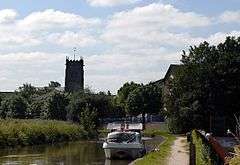 The parish church of St. Michael and All Angels seen over the Trent and Mersey Canal | |
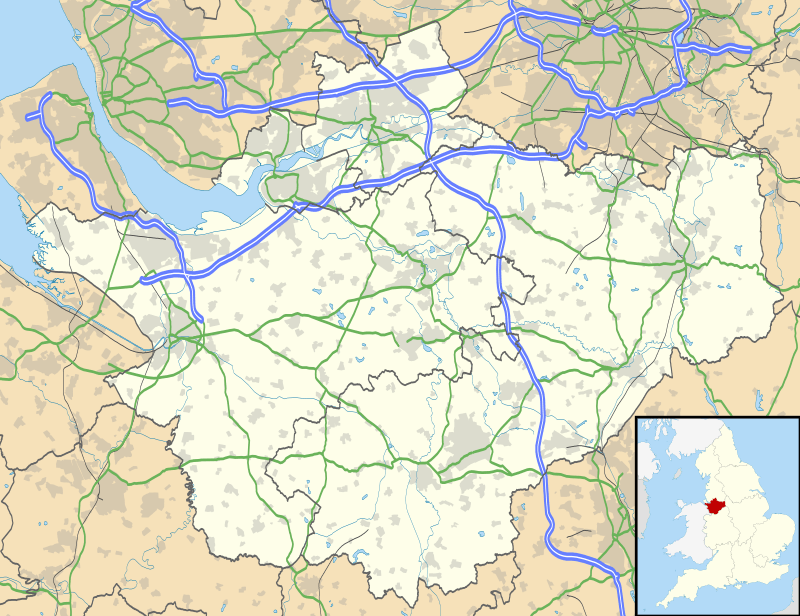 Middlewich Location within Cheshire | |
| Population | 13,595 (2011 Census) |
| OS grid reference | SJ704663 |
| • London | 153 miles (264 km) SE |
| Unitary authority | |
| Ceremonial county | |
| Region | |
| Country | England |
| Sovereign state | United Kingdom |
| Post town | MIDDLEWICH |
| Postcode district | CW10 |
| Dialling code | 01606 |
| Police | Cheshire |
| Fire | Cheshire |
| Ambulance | North West |
| UK Parliament | |
Middlewich lies on the confluence of three rivers: the Dane, Croco and Wheelock. Three canals also pass through the town, the Shropshire Union, Trent and Mersey, and the Wardle Canal, as well as three major roads, the A533, A54 and A530; Middlewich also has good motorway links to the nearby cities of Manchester and Liverpool. The town's population has doubled since 1970 despite a reduction in the number of manufacturing jobs in salt and textile manufacturing, suggesting that many of the new residents live in Middlewich for reasons other than local employment.
Since 1990 there have been initiatives to increase the volume of tourism into the town, through events such as the annual folk and boat festival, the Roman and Norman festivals, and regular farmers' markets.
In 2014, it was rated one of the most attractive postcode areas to live in England.[2]
History

In the Domesday Book Middlewich is spelt "Mildestvich"; the termination wic or wyc in Old English refers to a settlement, village or dwelling. It is also supposed that "wich" or "wych" refers to a salt town, with Middlewich being the middle town between Northwich and Nantwich.[3]
Middlewich was founded by the Romans, who gave it the name Salinae because of its surrounding salt deposits. It became one of the major Roman sites for salt production, an activity that was centred on the township of Kinderton, about a quarter of a mile north of the present-day parish church of St. Michael and All Angels. It has been suggested that pre-Roman salt production also occurred in the same area, but there is no supporting archaeological evidence.[4][5] Whittaker's History of Manchester claims that the Iron Age Cornovii made Kinderton their capital,[3] but it is more likely that the Cornovii inhabited Kinderton for its salt-making potential.[6][7] There was once thought to have been a medieval castle at Kinderton, but that is now thought to have been unlikely.[8]
Middlewich lies across the King Street fault, which roughly follows the Roman road, King Street, from Northwich to Middlewich.[5] During their occupation the Romans built a fort at Harbutts Field (grid reference SJ70216696),[9][10] and excavations to the south of the fort have found further evidence of Roman activity[11][12] including a well and part of a preserved Roman road. An excavation in 2004, in Buckley's Field,[13] also uncovered signs of Roman occupation.
Salt manufacture has remained the principal industry for the past 2,000 years, and it has shaped the town's history and geography. Before the Norman invasion of England in 1066, there is thought to have been one brine pit in Middlewich, between the River Croco and the current Lewin Street.[14] In the Domesday Book the area is described as being "wasted",[14] having been cleared by King William around 1070 as an "act of rage against his rebellious barons".[15] Gilbert de Venables became the first Baron of Kinderton shortly after the Norman Conquest, the title being conferred by Hugh Lupus.[16] A manor house was built to the east of the town and became the baronial seat of the Venables family. A Jacobean screen in the church of St Michael and All Angels has the carved Venables coat of arms. The title "Baron of Kinderton" is now vested in the Lord Vernon.
On 13 March 1643 the town was the scene of the first Battle of Middlewich, between the Parliamentarians, under Sir William Brereton, and the Royalist supporters of King Charles I of England, under Sir Thomas Aston.[17] The second Battle of Middlewich took place on 26 December 1643, and claimed the lives of about 200 Parliamentarians, along with a number of Royalists under the command of Lord Byron.
The population of Middlewich rose during the 19th and 20th centuries. Some of this rise is attributable to a number of parishes being combined, for example parts of Newton were added to Middlewich in 1894, with Sutton having previously been added to Newton in 1892. Some will also be due to a general increase in population of the United Kingdom, and some of the increase would have been required to provide a labour force for the increased number, and scale, of salt and chemical works in the town. In the middle of the 19th century Middlewich was described as a town with principal works being the surrounding farming district, a silk factory, and the salt works in Kinderton and Newton.[18] In 1887 the town was described as having an antique appearance, with its principal trade being salt, along with fruit and vegetables, and small silk and heavy cotton works. The town had one bank and one newspaper.[19] By 1911 the Encyclopædia Britannica mentions the existence of chemical works and the manufacture of condensed milk.

In common with the rest of the United Kingdom, Middlewich's young male population was decimated during the First World War. The cenotaph, near to the parish church,[20] lists the names of the 136 men who died in that conflict, representing around 10% of the male population of the town aged between 15 and 45. Forty-two of Middlewich's inhabitants lost their lives in the Second World War, with a further fatality in the Korean War. The Brunner Mond salt works in Brooks Lane also erected a cenotaph in memory of the 16 men from the works killed in the First World War, and the two who died during the Second World War.[21][22]
In the period between the end of the First World War until shortly after the Second World War, there was extensive housebuilding in the town; a significant number of houses were built in the King Street area to the north, the area bounded between Nantwich Road and St. Anne's Road to the west, and especially in Cledford to the south. The 1970s commenced with the building of a new road, St. Michael's Way, which allowed traffic moving from east to west through the town to bypass the main shopping street, Wheelock Street. Along with the bypass there was significant remodelling of the town centre, with the old town hall and library being demolished. This bypass successfully eased the flow of traffic away from the main shopping street, but the joining of three major roads remains a bottleneck, which will be eased by a proposed eastern bypass.[23]
Since the early 1980s Middlewich has seen a significant quantity of new housing development, initially in the Sutton Lane and Hayhurst Avenue areas. New developments have recently been built on the sites of old salt workings to the south of the Roman Fort at Harbutt's Field, near the Norman Baron's moated manor house at Kinderton Manor, and on the site of the old railway station. One of the latest developments is on the old silk works next to the Big Lock public house. In common with other local towns such as Holmes Chapel, Northwich and Winsford, people are attracted to Middlewich because of its good road links via the M6 motorway and the relatively low price and availability of suitable building land.[24]
Governance
Middlewich has lain within the county boundaries of Cheshire since a very early time. At the time of the Domesday survey (1086) Middlewich was in the hundred of Middlewich, but by the 14th century it had become part of the Northwich hundred, although a small part of the then large parish of Middlewich extended into the hundred of Eddisbury.[25] Following the Local Government Act 1894, Middlewich became an urban district.[26] In 1974, as part of the Local Government Act 1972, Middlewich Urban District was abolished and its territory passed into the borough of Congleton.[27] Since 1 April 2009 the town has been served by Cheshire East Council.[28] The town also has a town council, which is responsible for presiding over local issues in Middlewich. The largest party on the council is Labour.
Middlewich is in the parliamentary constituency of Congleton. The current MP is Fiona Bruce for the Conservative Party, elected in the 2010 General Election. Previously, Ann Winterton, also a member of the Conservative Party, had been the MP since the constituency's creation in 1983.
Geography
| Middlewich | ||||||||||||||||||||||||||||||||||||||||||||||||||||||||||||
|---|---|---|---|---|---|---|---|---|---|---|---|---|---|---|---|---|---|---|---|---|---|---|---|---|---|---|---|---|---|---|---|---|---|---|---|---|---|---|---|---|---|---|---|---|---|---|---|---|---|---|---|---|---|---|---|---|---|---|---|---|
| Climate chart (explanation) | ||||||||||||||||||||||||||||||||||||||||||||||||||||||||||||
| ||||||||||||||||||||||||||||||||||||||||||||||||||||||||||||
| ||||||||||||||||||||||||||||||||||||||||||||||||||||||||||||
Middlewich is located at 53°11′31″N 2°26′35″W (53.192, −2.443), on the confluence of three rivers, the Dane, the Croco and the Wheelock. The town is approximately 2.5 miles (4.0 km) from junction 18 of the M6 motorway. The main westward traffic route between the motorway and Winsford, and also southbound traffic to Crewe, go through the town. There are three canals in Middlewich, the Middlewich Branch of the Shropshire Union Canal, the Trent and Mersey Canal, and the Wardle Canal, the United Kingdom's shortest canal at 100 feet (30 m) long.[29][30]
The town sits less than 98 feet (30 m) above sea level, on Upper Triassic Mercia mudstone laid down with large salt deposits as part of the Cheshire plain, a boulder clay plain separating the hills of North Wales and the Peak District of Derbyshire, formed following the retreat of ice age glaciers.[31]
The climate is generally temperate with few extremes of temperature or weather. The mean average temperature is slightly above average for the United Kingdom as is the average amount of sunshine.[32][33] The average annual rainfall is slightly below the average for the UK.[34] There are few days when snow is lying on the ground, although there are some days of air frost.[35][36]
Demography

At the 2001 UK census, the Middlewich wards of Cledford and Kinderton had a total population of 13,101.[37] Middlewich's population is relatively young; the proportion of children (aged 0–15) is 3% higher than the national average.[38][39] Households are larger than average, consistent with a younger population, with an average of 2.51 people per household,[38] compared to the national average of 2.36. Approximately 25% are single person households, compared to 30% nationally; the majority (almost 85%) of Middlewich's housing stock is owner-occupied.[38]
Three-quarters of the 9,500 people between the ages of 16 and 74 are classed as "economically active", that is, either in full or part-time employment, or full-time students.[38] Unemployment runs at around 2.2%, compared to 3.4% nationally. Eighty-seven percent of households own at least one car, primarily used for travel to and from work; nearly 77% of residents travel to work by car, 10% work from home, and the remainder use public transport, walk, or cycle.[38]
| Population of Middlewich since 1801 | |||||||||||||||||||
|---|---|---|---|---|---|---|---|---|---|---|---|---|---|---|---|---|---|---|---|
| Year | 1801 | 1841 | 1851 | 1891 | 1901 | 1911 | 1921 | 1931 | 1939 | 1951 | 1961 | 1971 | 1981 | 1991 | 2001 | 2011 | |||
| Population | 1,190 | 1,242 | 1,235 | 3,706 | 4,669 | 4,909 | 5,115 | 5,458 | 6,390 | 6,736 | 6,863 | 7,853 | 8,300 | 11,913 | 13,101 | 13,595 | |||
| Sources:[37][40][41][42] | |||||||||||||||||||
At the 2001 census, 16.3% of the population of Middlewich either did not answer the question about religion, or stated that they had no religion.[38] The breakdown for Congleton showed that 99.3% of those that replied, and did not state that they had no religion, were Christian; the figures for Middlewich will be broadly similar.[43]
Economy
Middlewich has a traditional high street, with small shops on Wheelock Street and Lewin Street. There are also five supermarkets, Tesco, Lidl, Jacks, a Tesco Express, and Morrisons.[44] Historically the major employers have been the salt industry and agriculture. Salt is still manufactured at British Salt, which employs around 125 people. The close proximity to the M6 motorway has led to the creation of a large distribution and business park, with companies such as Tesco and ERF locating to the site.[45] Approximately 300 people are employed at the Ideal Standard factory, which since 1937 has been making vitreous china sanitaryware.[46]
Tourism is one of the fastest growing industries in Cheshire,[47] and Congleton East Council has recognised the importance of Middlewich's canals in its attempts to promote tourism in the borough.[48] Visitors to the 2003 Middlewich Folk and Boat Festival were estimated to have spent £2.3 million in the town over the two days of the festival.[49]
Power for the town is provided from the National Grid for electricity, and National Grid Gas plc for natural gas. Fresh water supply and foul water collection is by United Utilities.
Culture and community
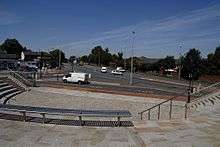
A highly regarded folk and boat festival has been run in the town every year since 1990, except for 2001 when it was cancelled because of a foot and mouth epidemic.[50] During the three-day festival (which takes place over a long weekend) folk artists play at a number of locations in the town, and it is estimated to bring in an extra 30,000 visitors to the town during the festival period, along with 400 narrowboats.[51]
In addition to this annual event there have been a number of ad-hoc events, including the Middlewich Roman Festival in 2001. This Roman Festival led to a Heritage lottery fund grant which allowed the construction of a Roman theatre at the Bull Ring near to St Michaels and All Angels church. Since its construction this has regularly been used for other purposes, such as an open-air music stage and an ice-rink. Following the Roman festival in 2001, further Roman festivals were held in 2003 and 2007. Tim Strickland, a consultant archaeologist, was awarded a MBE for services to archaeology for his work in organising the Roman Middlewich Project.[52][53] In 2005 a Norman Festival was put on in the town, and there are plans for an Industrial Festival.[54][55] A series of arts and music events "@ the Bull Ring" was started in 2006.[56]
The local newspapers are the Middlewich Guardian and Middlewich Chronicle. A radio station, Cheshire FM, was launched in 2007, covering the mid-Cheshire area including Middlewich – this closed in 2012. In 2013 a new local radio station was launched, Mid-Cheshire Radio covering Middlewich and the nearby towns of Northwich and Winsford. The library, in Lewin Street, was built in the 1970s to replace the old library which was demolished to build St Michael's Way. It has examples of finds from Middlewich's Roman past on display.[57] Fountain Fields on Queen Street is a traditional town park, with a number of facilities including a bowling green. It has been owned by the council since 1926.[58]
Middlewich has had a football club since at least 1902. The current club, Middlewich Town, was formed in 1998, and plays in the Mid-Cheshire League. Middlewich also has a cricket club on Croxton Lane. There is a leisure centre[59] which shares facilities with the high school. Middlewich is one of two large towns in the former borough of Congleton without a public swimming pool, in spite of the various initiatives that have been started to provide one.[60]
Middlewich's hospital is Leighton Hospital near Crewe, part of the Mid Cheshire Hospitals National Health Service Trust. Primary care services are provided by the Central and Eastern Cheshire Primary Care Trust. GP services are provided by two medical practices. There are two dental practices.[61]
Landmarks and religious sites
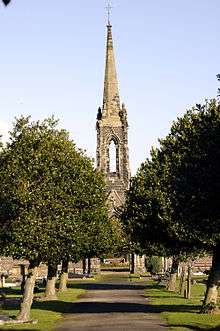
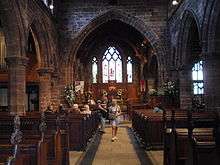
The principal landmark in Middlewich is the Anglican parish church of St Michael and All Angels, parts of which date back to the 12th century, although the majority was built during the 14th, 15th and 16th centuries. There was a general remodelling of the church during the 19th century, which included removing the whitewash from its interior to reveal the sandstone appearance seen today.[62] The church was the site of fierce fighting in the first and second Battles of Middlewich during the English Civil War.
Other landmarks include: the Roman Theatre built on the Bull Ring on the site of the old town hall and library; and the town bridge, opened in 1931 as a replacement for an earlier bridge.[63][64] Middlewich has a town cemetery with a twin chapel dating from 1859 by Bellamy & Hardy;[65] it contains the Commonwealth war graves of 21 British service personnel, 17 from World War I and 4 from World War II.[66] The Victoria technical school and library, which was opened in 1897, is a red brick and red terracotta building, "with a cupola but otherwise vaguely in the Loire style".[65] Since 1900, the building on Lewin Street has been used as offices by the Town Council.[63] One mile north of the town centre along King Street lies Ravenscroft Hall, which dates from 1837.[65]
There are places of worship for five Christian denominations within the town: Church of England, Methodist, United Reformed Church, Catholic and Pentecostal. There are no places of worship for non-Christian faiths.[67]
Middlewich Methodist Church was built in 2000 in Booth Lane, replacing the earlier chapel in Lewin Street.[68] Middlewich United Reformed Church (Image) was founded in 1797, with the current church (the second on this site) in Queen Street being built in 1870,[63] and completed in 1871. The church celebrated its bicentenary in 1997 with the publication of a history of the church, Two Hundred Years (not out).[69][70]
Catholic masses were held in a cottage near the cemetery from 1848 until the building of the first Catholic church in the town in Wych House Lane in 1864. This church was enlarged to include the first Catholic school in the town in 1869.[63] The church was later replaced by the modern St Mary's Catholic Church on New King Street (Image) in 1890, with the stone cross from the church on Wych House Lane being kept within the porch of the new church.
Middlewich Community Church (Image) is a relatively new Pentecostal church located in the former social club for the Brunner Mond works in Brooks Lane.
Transport
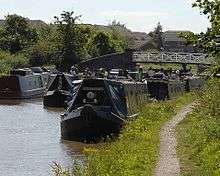
Middlewich lies on the A533 road linking it to Northwich and Runcorn in the north, and Sandbach to the south, the A54 linking it to Chester and Winsford to the west and Holmes Chapel and Buxton to the east, and A530 linking it to Crewe and Nantwich to the south.[71]
Middlewich lies on a railway branch line between Sandbach and Northwich, but Middlewich railway station – opened in 1868 and closed to passenger traffic in 1959 – has been demolished.[72] The branch line is still used by freight trains. The closest railway station is at Winsford, 2.3 miles (3.7 km) away.[73] Efforts to get the line reopened to passenger traffic and have a new station built have been on going for nearly 30 years.[74] In 2018, a request from the government to create an outline business case was announced. The request is being handled by Cheshire East Council in conjunction with Cheshire West and Chester Council and the Cheshire and Warrington Local Enterprise Partnership and will consider the cost and benefits ot reopening the line and building new stations at Middlewich and Gadbrook Park.[75]
Following a petition in 1766, the Trent and Mersey Canal was diverted from its original course to provide transport to the town,[63] and now links with a branch of the Shropshire Union Canal. The link between the two canals, which was opened in 1833,[76] is actually a third canal known as the Wardle Canal; at about 100 feet (30 m) in length, it is the shortest canal in the United Kingdom.
Middlewich is 19 miles (31 km) from Manchester Airport, the busiest airport in the UK outside London,[77] and 26 miles (42 km) from Liverpool John Lennon Airport.
Education
There were three schools in Middlewich in the mid-19th century: the British School in Newton Bank; the National School in Cow Lane (Brooks Lane); and the Grammar School, close to the site of the largest Tesco store. A Church of England school was erected in Lewin Street in 1854 and extended in 1871. It soon became known as the National School, with the result that the earlier school was demolished. The later National School was itself demolished in the 1980s and is the site of the Salinae Day Care Centre, opened in 1995.[78] At the turn of the 20th century two new schools were built: St Mary's Catholic school, whose keystone was laid in 1899 by Col. France-Hayhurst, and the secondary school, opened by France-Hayhurst in 1906. At the start of the 21st century there were seven schools in Middlewich: one infant, one junior, four primary schools and one secondary school. Cledford Primary School tends to accept students from the South of the town. It has now amalgamated With Cledford Infant And Nursery School. Middlewich Primary School caters for children from the older, northern, part of the town,"Middlewich Primary School". Retrieved 30 May 2006. whilst St Mary's Catholic Primary School receives Catholic children from the town."St Mary's Catholic Primary School". Archived from the original on 19 May 2006. Retrieved 30 May 2006. Work began on the original buildings for the secondary school, Middlewich High School, in 1906,"School is 100 not out". This is Cheshire 11 November 2006. Archived from the original on 27 September 2007. Retrieved 11 December 2006. with later additions improving the teaching areas and providing a sports hall which could also be used by the wider community. The school opened on 1 November 1906. In 2007 it was ranked 34 out of 50 by GCSE results for schools in Cheshire in the 2007 league tables."Schools in Cheshire". Education League Tables. Retrieved 23 November 2007. Byley Primary School and Wimboldsley Community Primary School serve children from outside the immediate bounds of the town."Wimboldsley Community Primary School". Archived from the original on 18 November 2003. Retrieved 30 May 2006.
Notable residents
Notable residents include the theologians John Hulse (1708–1790) who founded the Hulsean lectures at Cambridge University, and Theophilus Lindsey (1723 OS – 1808) who inspired the Feathers Tavern Petition against clerical subscription to the Thirty-Nine Articles, and so helped start one of the most profound debates within the Church of England in the 18th century.[79] Elizabeth Ashbridge (1713–55), an 18th-century Quaker minister, was born in the town, as was William Benbow (1787–1864), a nonconformist preacher, pamphleteer and publisher. He was a prominent figure of the Reform Movement for widening the franchise.
The France-Hayhurst family were local landowners responsible for the development of the model village at Bostock, and Charles Frederick Lawrence (1873–1940) was a local antiquarian who documented much of the early history of Middlewich, and also discovered a Neolithic stone celt whilst digging in the town.[4] John Wright Oakes (1820–1887) born at Sproston House, was a landscape painter[80] who exhibited regularly at the Royal Academy. Craig McDean (born 1964) is a British fashion photographer who was born in the town and is now based in New York City.
James Hargreaves (1834–1915) was a chemist and inventor, who, along with Thomas Bird, developed a process for the electrolysis of brine using asbestos diaphragms. In 1899, he became director of the newly opened General Electrolytic Alkali Company at Middlewich.[81]
Jack Wilkinson (1931–1996), also born in the town, was an English footballer for eight years who scored 81 goals in 158 league games.
References
- "Town population 2011". Neighbourhood Statistics. Office for National Statistics. Retrieved 13 March 2016.
- "UK's 'most desirable' postcodes revealed". BBC News.
- C F Lawrence (1936). The story of Bygone Middlewich.
- Barry, Memories of Middlewich
- George Twigg. "19th–20th century Middlewich". Salt making sites in Cheshire. Archived from the original on 1 September 2006. Retrieved 26 June 2006.
- Institute of Historical Research (1848). 'Congleton', A Topographical Dictionary of England. Retrieved 11 December 2006.
- "The Celtic Tribes of Britain – The Cornovii". WWW.Roman-Britain. ORG. Archived from the original on 13 December 2006. Retrieved 11 December 2006.
- "Monument No. 74705". National Monuments Record. English Heritage. Archived from the original on 16 July 2012. Retrieved 13 April 2009.
- "Roman Fort Minor Salt-Working Settlement". WWW.Roman-Britain. ORG. Archived from the original on 9 May 2006. Retrieved 10 September 2006.
- "Fieldwork 1999". Historic Environment Fieldwork Full Summary. Archived from the original on 19 February 2006. Retrieved 21 May 2006.
- "Fieldwork 2000". Historic Environment Fieldwork Full Summary. Archived from the original on 19 February 2006. Retrieved 21 May 2006.
- "Fieldwork 2001". Historic Environment Fieldwork Full Summary. Archived from the original on 19 February 2006. Retrieved 21 May 2006.
- "Roman dig – update" (PDF). Cheshire Matters. Archived from the original (PDF) on 27 September 2007. Retrieved 21 May 2006.
- Earl, Middlewich 900–1900.
- "Cheshire and the Domesday Book". infokey.com. Archived from the original on 22 August 2006. Retrieved 24 September 2006.
- "Kinderton-cum-Hulme, 1850". Northwich, Cheshire, UK. Local Genealogy and History. Archived from the original on 22 October 2009. Retrieved 2 April 2007.
- "Person Page". Thepeerage.com. Retrieved 21 September 2018.
- "Middlewich 1850". Northwich, Cheshire, UK. Local Genealogy and Local History. Archived from the original on 22 October 2009. Retrieved 21 May 2006.
- Bartholomew, John (1887). Gazetteer of the British Isles.
- Image of the town cenotaph, Upload.wikimedia.org
- Image of the Brunner Mond cenotaph, Upload.wikimedia.org
- 15 of the 16 names from the First World War are duplicated on the town cenotaph, as are both from the Second World War. Arthur Harrison's name does not appear on the town cenotaph.
- "Middlewich Eastern Bypass (Southern Section)" (PDF). Environmental Statement, Non-Technical Summary. Archived from the original (PDF) on 27 September 2007. Retrieved 22 May 2006.
- "Action plan will address people's negative feeling". Middlewich Guardian. Archived from the original on 7 September 2012. Retrieved 2 February 2008.
- Harris, B. E.; A. T. Thacker (1987). The Victoria History of the County of Chester. Volume 1: Physique, Prehistory, Roman, Ango-Saxon, and Domesday. Oxford: Oxford University Press. pp. 340–341. ISBN 0-19-722761-9.
• "Translation of Great Domesday Book Folio 267r" (PDF). Wheelock Genealogy. Archived from the original (PDF) on 9 May 2008. Retrieved 23 June 2009.
• Harris, B. E.; A. T. Thacker (1979). The Victoria History of the County of Chester. Volume 2. Oxford: Oxford University Press. pp. 191–192. ISBN 0-19-722749-X.
• "Middlewich". UKBMD – Births, Marriages, Deaths & Censuses on the Internet. - "Middleton (page 417)". Encyclopædia Britannica Eleventh Edition.
- "Congleton District Profile 2003" (PDF). Cheshire Current Facts & Figures. Archived from the original (PDF) on 29 September 2007. Retrieved 27 April 2007.
- Cheshire (Structural Changes) Order 2008 Archived 17 May 2009 at the Wayback Machine
- "Wardle Canal". Mike Stevens' UK Inland Waterways Pages. Retrieved 2 February 2008.
- "Fascinating facts about canals and rivers". waterscape.com. Retrieved 2 February 2008.
- The Environment Agency (2005). "Weaver and Dane Catchment Abstraction Management Strategy, Consultation Document" (PDF). Archived from the original (PDF) on 18 February 2006. Retrieved 16 April 2007.
- Met. Office:Average annual mean temperature. Archived 28 August 2013 at the Wayback Machine. Retrieved 15 April 2007.
- Met. Office:Average annual sunshine. Archived 22 February 2012 at WebCite. Retrieved 15 April 2007.
- Met. Office:Average annual rainfall. Archived 19 July 2013 at the Wayback Machine. Retrieved 15 April 2007.
- Met. Office:Days of snow lying. Archived 9 August 2007 at the Wayback Machine. Retrieved 15 April 2007.
- Met. Office:Days of air frost. Archived 5 July 2007 at the Wayback Machine. Retrieved 15 April 2007.
- "Key Stats by Town & Ward – Census Results 2001" (PDF). Congleton Borough Council. Archived from the original (PDF) on 5 December 2009. Retrieved 14 March 2008.
- "Census Area Profile" (PDF). 2001 Census. Archived from the original (PDF) on 27 September 2007. Retrieved 21 May 2006.
- "National Statistics Online". 2001 Census. Retrieved 21 May 2006.
- "Middlewich, 1850". Northwich, Cheshire, UK. Local Genealogy and History. Archived from the original on 22 October 2009. Retrieved 14 March 2008.
- "Middlewich USD: Total Population". A Vision of Britain through Time. Retrieved 14 March 2008.
- "Middlewich UD: Total Population". A Vision of Britain through Time. Retrieved 14 March 2008.
- "Census 2001:Key Statistics for Local Authorities in England and Wales" (PDF). Archived from the original (PDF) on 22 December 2003. Retrieved 22 November 2007.
- "Middlewich supermarket proposals are blasted". Crewe Chronicle. 8 October 2008. Retrieved 27 October 2008.
- "Cheshire Business Parks" (PDF). Cheshire County Council. Archived from the original (PDF) on 12 June 2009. Retrieved 1 February 2008.
- "Solids recovery reduces costs and minimises waste" (PDF). Environmental Technology Best Practice Programme. June 1997. Retrieved 5 April 2007.
- "Congleton Renaissance" (PDF). Congleton Borough Council. Archived from the original (PDF) on 17 March 2010. Retrieved 13 March 2008.
- "Middlewich Canal Projects". Congleton Borough Council. Retrieved 13 March 2008.
- "Festival could boost economy". Newsquest Media Group. 30 April 2003. Retrieved 14 March 2008.
- "Middlewich Folk and Boat Festival 2006". The Mudcat Cafe. Archived from the original on 6 October 2007. Retrieved 22 May 2006.
- "Festival 2006". Middlewich Folk and Boat Festival. Retrieved 3 February 2008.
- Strickland and Sumner, Roman Middlewich: A Story of Roman and Briton in Mid-Cheshire.
- "Awards". Middlewich Town Council. Archived from the original on 10 December 2006. Retrieved 13 April 2007.
- "Norman Middlewich". Archived from the original on 30 December 2005. Retrieved 22 May 2006.
- "Memories would be captured on CD for posterity". This Is Cheshire Work. 22 February 2006. Archived from the original on 27 September 2007. Retrieved 22 May 2006.
- "What's On". Middlewich Town Council. Archived from the original on 14 May 2006. Retrieved 26 June 2006.
- "Middlewich Library". Archived from the original on 4 April 2007. Retrieved 22 April 2007.
- "Massive boost for town's park life". Messenger newspapers. Retrieved 22 April 2007.
- "Middlewich Leisure Centre". Archived from the original on 28 September 2007. Retrieved 22 April 2007.
- "Lost cash found thanks to Guardian". This is Cheshire. Archived from the original on 11 October 2007. Retrieved 13 April 2007.
- "Local Search Results for CW10". Archived from the original on 26 September 2007. Retrieved 22 April 2007.
- "About the Church". Middlewich Parish Church. Archived from the original on 8 December 2004. Retrieved 22 May 2006.
- Earl, A.L. (1990). Middlewich, 900 – 1900.
- P. J. Andrews and R. M. Williams (1981). Middlewich in Times Past. ISBN 0-86157-051-0.
- Nikolaus Pevsner and Edward Hubbard (1971). The Buildings of England: Cheshire.
- "Middlewich Cemetery, with list of casualties". Commonwealth War Graves Commission. Retrieved 31 January 2019.
- "Middlewich Places of Worship". Archived from the original on 28 October 2007. Retrieved 21 November 2007.
- "Last services at old building". this is Cheshire. Archived from the original on 11 October 2007. Retrieved 22 May 2006.
- "Middlewich URC". Retrieved 11 June 2006.
- E.Birchall and R.Clewes (1997). Two Hundred Years (not out) – The history of Queen Street Church, Middlewich (Congregational/United Reformed) 1797–1997.
- Ordnance Survey, Landranger 118 map
- "Campaigners roll off on a nostalgic journey". This is Cheshire. Archived from the original on 27 September 2007. Retrieved 1 September 2007.
- "Local Area Transport". UpMyStreet. Retrieved 4 February 2008.
- "'Major boost' for Mid Cheshire Rail Link, says campaign group". Middlewich Guardian. Retrieved 12 July 2018.
- "Business case requested for Middlewich reopening". Railmagazine.com. Retrieved 12 July 2018.
- "Late Georgian and Victorian Chester 1762–1914 The economy, 1762–1840: the demise of old Chester". A History of the County of Chester: Volume 5 (i). Retrieved 3 October 2006.
- Wilson, James (26 April 2007). "A busy hub of connectivity". Financial Times – FT report – doing business in Manchester and the NorthWest. The Financial Times Limited.
- "Salinae Day Care Centre". Cheshire County Council. Archived from the original on 29 September 2007. Retrieved 30 May 2006.
- "About Theophilus Lindsey". The Correspondence of Theophilus Lindsey. Archived from the original on 30 September 2007. Retrieved 26 April 2007.
- Dictionary of National Biography, 1885–1900, Volume 41, Oakes, John Wright retrieved 16 July 2018
- Hardie, A history of the chemical industry in Widnes, pp. 193–194, 197.
Bibliography
- Barry, M. (1972). Memories of Middlewich. Sherratt. ISBN 0-85427-032-9.
- Earl, A. L. (1990). Middlewich 900–1900. Ravenscroft Publications. ISBN 978-1-873139-01-1.
- Hardie, D. W. F. (1950). A History of the Chemical Industry in Widnes. London: Imperial Chemical Industries.
- Strickland, T. J.; Sumner, G. (2001). Roman Middlewich: A Story of Roman and Briton in Mid-Cheshire. Roman Middlewich Project. ISBN 978-0-9541186-0-0.
Further reading
- Earl, A. L. (1994). Middlewich, 1900–1950, Cheshire Country Publishing, ISBN 978-0-949001-10-8
- Curzon, B. J.; Hurley, P. (2005).Middlewich (Images of England Series), NPI Media Group, ISBN 978-0-7524-3520-6
- Coward, T. A. (1903). Picturesque Cheshire, Chester & the Welsh Border
- Bartholomew, J. (1887). Gazetteer of the British Isles
- Lawrence, C. L. (1905/1936). Bygone Middlewich
External links
| Wikimedia Commons has media related to Middlewich. |
| Wikivoyage has a travel guide for Middlewich. |
- Historical links
- Other links